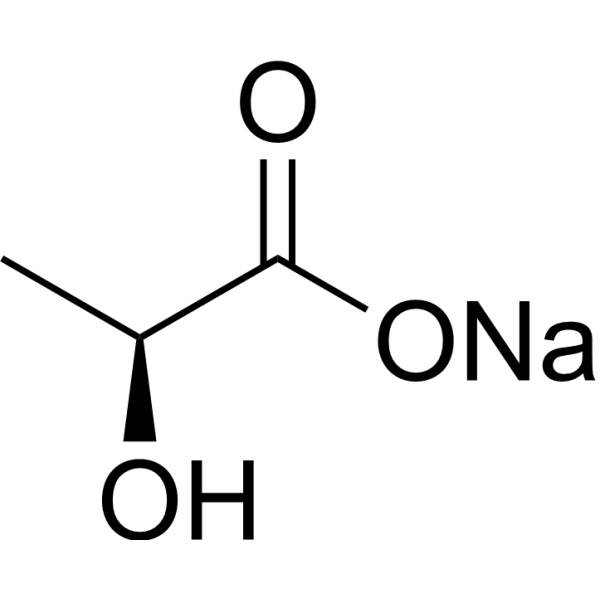
| 规格 | 价格 | 库存 | 数量 |
|---|---|---|---|
| 1mg |
|
||
| 2mg |
|
||
| 5mg |
|
||
| 10mg |
|
||
| 50mg |
|
||
| 100mg |
|
||
| 250mg |
|
||
| 500mg |
|
||
| 1g |
|
||
| Other Sizes |

| 靶点 |
Precursor for bioplastic polymer poly-lactic acid
|
|---|---|
| 体外研究 (In Vitro) |
为了开发有助于修复中枢神经系统(CNS)损伤的组织工程策略,设计模拟神经干细胞小生境及其对神经细胞起源、生长和分化的严格控制的支架至关重要。在这项研究中,我们测试了两种类型的聚L/DL乳酸(PLA95/5和PLA70/30)作为神经再生材料,这是一种可生物降解的材料,允许神经细胞粘附和生长。两种PLA都具有轻微的疏水性和负电荷,但结晶度、硬度和降解速率不同。PLA95/5膜是高度结晶的、坚硬的(GPa),并且在培养物中分析的一个月内没有显著降解。相反,PLA70/30膜更无定形、更柔软(MPa)且降解更快,向培养基中释放大量乳酸。在原代皮层神经细胞的粘附、增殖和分化方面,PLA70/30比PLA95/5表现更好,在体外维持神经元和神经胶质祖细胞库。培养基中的L-乳酸概括了PLA70/30对神经元限制性祖细胞的维持,但不维持培养物中的双电位或神经胶质限制性祖祖细胞,如神经细胞在PLA70/30上生长时所发生的那样。我们的结果表明,PLA70/30可能模拟NSC生态位的一些物理和生物化学特征。它的机械和表面性质可能协同调节双电位和神经胶质限制性祖细胞表型,而它是L-乳酸盐,添加到培养基中或通过膜释放,驱动神经元限制性祖电池型的维持[1]。
|
| 细胞实验 |
在原代皮层神经细胞的粘附、增殖和分化方面,PLA70/30比PLA95/5表现更好,在体外维持神经元和神经胶质祖细胞库。培养基中的L-乳酸概括了PLA70/30对神经元限制性祖细胞的维持,但不维持培养物中的双电位或神经胶质限制性祖祖细胞,如神经细胞在PLA70/30上生长时所发生的那样[1]。
|
| 参考文献 | |
| 其他信息 |
To develop tissue engineering strategies useful for repairing damage in the central nervous system (CNS) it is essential to design scaffolds that emulate the NSC niche and its tight control of neural cell genesis, growth, and differentiation. In this study we tested two types of poly L/DL lactic acid (PLA95/5 and PLA70/30), a biodegradable material permissive for neural cell adhesion and growth, as materials for nerve regeneration. Both PLA were slightly hydrophobic and negatively charged but differed in crystallinity, stiffness and degradation rate. PLA95/5 films were highly crystalline, stiff (GPa), and did not degrade significantly in the one-month period analyzed in culture. In contrast, PLA70/30 films were more amorphous, softer (MPa) and degraded faster, releasing significant amounts of lactate into the culture medium. PLA70/30 performs better than PLA95/5 for primary cortical neural cell adhesion, proliferation and differentiation, maintaining the pools of neuronal and glial progenitor cells in vitro. L-lactate in the medium recapitulated PLA70/30's maintenance of neuronal restricted progenitors but did not sustain bipotential or glial restricted progenitors in the cultures, as occurred when neural cells were grown on PLA70/30. Our results suggest that PLA70/30 may mimic some of the physical and biochemical characteristics of the NSC niche. Its mechanical and surface properties may act synergistically in the modulation of bipotential and glial restricted progenitor phenotypes, while it is L-lactate, either added to the medium or released by the film that drives the maintenance of neuronal restricted progenitor cell phenotypes.[1]
|
| 分子式 |
C3H5NAO3
|
|---|---|
| 分子量 |
112.06
|
| 精确质量 |
112.013
|
| 元素分析 |
C, 32.16; H, 4.50; Na, 20.52; O, 42.83
|
| CAS号 |
867-56-1
|
| 相关CAS号 |
L-Lactic acid;79-33-4;Sodium (S)-2-hydroxypropanoate-d3;285979-84-2;Sodium (S)-2-hydroxypropanoate-2-d;285979-83-1
|
| PubChem CID |
23664767
|
| 外观&性状 |
White to off-white solid
|
| 密度 |
1.33
|
| 沸点 |
227.6ºC at 760 mmHg
|
| 熔点 |
163-165ºC
|
| 闪点 |
109.9ºC
|
| 折射率 |
1.422-1.425
|
| tPSA |
60.36
|
| 氢键供体(HBD)数目 |
1
|
| 氢键受体(HBA)数目 |
3
|
| 可旋转键数目(RBC) |
1
|
| 重原子数目 |
7
|
| 分子复杂度/Complexity |
63.2
|
| 定义原子立体中心数目 |
1
|
| SMILES |
[C@H](O)(C)C(=O)O.[Na]
|
| InChi Key |
NGSFWBMYFKHRBD-DKWTVANSSA-M
|
| InChi Code |
InChI=1S/C3H6O3.Na/c1-2(4)3(5)6;/h2,4H,1H3,(H,5,6);/q;+1/p-1/t2-;/m0./s1
|
| 化学名 |
sodium;(2S)-2-hydroxypropanoate
|
| 别名 |
sodium (S)-2-hydroxypropanoate; sodium (S)-2-hydroxypropanoate; Sodium-L-lactate; L-Lactic acid sodium salt; Sodium lactate, l-; Sodium (S)-lactate; L-(+)-Lactic acid sodium salt; Sodium-L-lactate; L-Lactic acid sodium salt
|
| HS Tariff Code |
2934.99.9001
|
| 存储方式 |
Powder -20°C 3 years 4°C 2 years In solvent -80°C 6 months -20°C 1 month 注意: 请将本产品存放在密封且受保护的环境中,避免吸湿/受潮。 |
| 运输条件 |
Room temperature (This product is stable at ambient temperature for a few days during ordinary shipping and time spent in Customs)
|
| 溶解度 (体外实验) |
H2O: ~250 mg/mL (2231 mM)
|
|---|---|
| 溶解度 (体内实验) |
注意: 如下所列的是一些常用的体内动物实验溶解配方,主要用于溶解难溶或不溶于水的产品(水溶度<1 mg/mL)。 建议您先取少量样品进行尝试,如该配方可行,再根据实验需求增加样品量。
注射用配方
注射用配方1: DMSO : Tween 80: Saline = 10 : 5 : 85 (如: 100 μL DMSO → 50 μL Tween 80 → 850 μL Saline)(IP/IV/IM/SC等) *生理盐水/Saline的制备:将0.9g氯化钠/NaCl溶解在100 mL ddH ₂ O中,得到澄清溶液。 注射用配方 2: DMSO : PEG300 :Tween 80 : Saline = 10 : 40 : 5 : 45 (如: 100 μL DMSO → 400 μL PEG300 → 50 μL Tween 80 → 450 μL Saline) 注射用配方 3: DMSO : Corn oil = 10 : 90 (如: 100 μL DMSO → 900 μL Corn oil) 示例: 以注射用配方 3 (DMSO : Corn oil = 10 : 90) 为例说明, 如果要配制 1 mL 2.5 mg/mL的工作液, 您可以取 100 μL 25 mg/mL 澄清的 DMSO 储备液,加到 900 μL Corn oil/玉米油中, 混合均匀。 View More
注射用配方 4: DMSO : 20% SBE-β-CD in Saline = 10 : 90 [如:100 μL DMSO → 900 μL (20% SBE-β-CD in Saline)] 口服配方
口服配方 1: 悬浮于0.5% CMC Na (羧甲基纤维素钠) 口服配方 2: 悬浮于0.5% Carboxymethyl cellulose (羧甲基纤维素) 示例: 以口服配方 1 (悬浮于 0.5% CMC Na)为例说明, 如果要配制 100 mL 2.5 mg/mL 的工作液, 您可以先取0.5g CMC Na并将其溶解于100mL ddH2O中,得到0.5%CMC-Na澄清溶液;然后将250 mg待测化合物加到100 mL前述 0.5%CMC Na溶液中,得到悬浮液。 View More
口服配方 3: 溶解于 PEG400 (聚乙二醇400) 请根据您的实验动物和给药方式选择适当的溶解配方/方案: 1、请先配制澄清的储备液(如:用DMSO配置50 或 100 mg/mL母液(储备液)); 2、取适量母液,按从左到右的顺序依次添加助溶剂,澄清后再加入下一助溶剂。以 下列配方为例说明 (注意此配方只用于说明,并不一定代表此产品 的实际溶解配方): 10% DMSO → 40% PEG300 → 5% Tween-80 → 45% ddH2O (或 saline); 假设最终工作液的体积为 1 mL, 浓度为5 mg/mL: 取 100 μL 50 mg/mL 的澄清 DMSO 储备液加到 400 μL PEG300 中,混合均匀/澄清;向上述体系中加入50 μL Tween-80,混合均匀/澄清;然后继续加入450 μL ddH2O (或 saline)定容至 1 mL; 3、溶剂前显示的百分比是指该溶剂在最终溶液/工作液中的体积所占比例; 4、 如产品在配制过程中出现沉淀/析出,可通过加热(≤50℃)或超声的方式助溶; 5、为保证最佳实验结果,工作液请现配现用! 6、如不确定怎么将母液配置成体内动物实验的工作液,请查看说明书或联系我们; 7、 以上所有助溶剂都可在 Invivochem.cn网站购买。 |
| 制备储备液 | 1 mg | 5 mg | 10 mg | |
| 1 mM | 8.9238 mL | 44.6190 mL | 89.2379 mL | |
| 5 mM | 1.7848 mL | 8.9238 mL | 17.8476 mL | |
| 10 mM | 0.8924 mL | 4.4619 mL | 8.9238 mL |
1、根据实验需要选择合适的溶剂配制储备液 (母液):对于大多数产品,InvivoChem推荐用DMSO配置母液 (比如:5、10、20mM或者10、20、50 mg/mL浓度),个别水溶性高的产品可直接溶于水。产品在DMSO 、水或其他溶剂中的具体溶解度详见上”溶解度 (体外)”部分;
2、如果您找不到您想要的溶解度信息,或者很难将产品溶解在溶液中,请联系我们;
3、建议使用下列计算器进行相关计算(摩尔浓度计算器、稀释计算器、分子量计算器、重组计算器等);
4、母液配好之后,将其分装到常规用量,并储存在-20°C或-80°C,尽量减少反复冻融循环。
计算结果:
工作液浓度: mg/mL;
DMSO母液配制方法: mg 药物溶于 μL DMSO溶液(母液浓度 mg/mL)。如该浓度超过该批次药物DMSO溶解度,请首先与我们联系。
体内配方配制方法:取 μL DMSO母液,加入 μL PEG300,混匀澄清后加入μL Tween 80,混匀澄清后加入 μL ddH2O,混匀澄清。
(1) 请确保溶液澄清之后,再加入下一种溶剂 (助溶剂) 。可利用涡旋、超声或水浴加热等方法助溶;
(2) 一定要按顺序加入溶剂 (助溶剂) 。